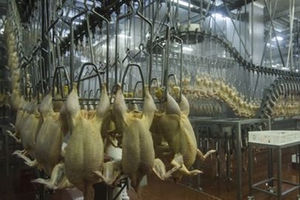 experts are scratching their heads after a Washington Post article suggested last week that certain chemicals used in poultry processing might be masking the presence of Salmonella. It’s a scandalous theory that could explain why government data show big reductions in Salmonella rates in poultry plants while human illnesses have held steady – but is it a real concern?
experts are scratching their heads after a Washington Post article suggested last week that certain chemicals used in poultry processing might be masking the presence of Salmonella. It’s a scandalous theory that could explain why government data show big reductions in Salmonella rates in poultry plants while human illnesses have held steady – but is it a real concern?According to the Post’s report, the U.S. Department of Agriculture’s Food Safety and Inspection Service is reviewing academic research that shows there “could be a problem.” The article cites a “lengthy PowerPoint presentation that cited research from a USDA scientist and several university scientists” that was presented at FSIS in June. The story says the compound under the most scrutiny is cetylpyridinium chloride (CPC), which is widely used in mouthwash and is a common finishing rinse for poultry to combat disease-causing pathogens.
The issue being raised is whether CPC, or other antimicrobials, might stick around in the samples collected for pathogen testing at a high enough concentration to kill the bacteria on the way to the lab, which would give FSIS a false negative test result when the chicken might very well be contaminated.
Asked about the concerns raised in the presentation, the USDA’s Food Safety and Inspection Service downplayed the issue, noting that it was not undertaking a formal review, but said officials are taking a look at the information that was presented. The agency said the new information “contributes to a well established dialogue on antimicrobial use in poultry processing” and that it “will take appropriate steps to adjust our policies and procedures if warranted.”
One of the scientists cited in the PowerPoint presentation, Catherine Cutter, a food safety professor at Penn State, said she did not know her research on CPC was being mentioned at the meeting and was a bit confused about why her study was referenced because it is 14 years old. She said she conducted the research so long ago that she no longer has her lab notebooks from the study.
On top of that, she pointed out that her study was about beef, not poultry, which is an “inherently different process.” For beef, pathogen testing is done by swabbing meat directly, but for chicken, the process requires rinsing the birds and then testing the resulting liquid for bacteria.
When the Post quoted Cutter as saying, “This is a valid concern,” she says was talking about her beef research.
“[CPC] stuck to everything. It sticks to whatever you put it on,” she said, noting that it has great cleaning capability for hides. “How [the paper] made the leap to chicken, I have no idea.”
One of the pieces of research at the heart of the controversy, it seems, was produced by Enviro Tech Chemical, one of the leading manufacturers of peracetic acid, another widely used poultry wash. The company’s research, which they posted online at the end of July also suggests that CPC should be labeled as a food additive if it lingers in product – an argument reminiscent of the controversy over the use of ammonium hydroxide in lean finely textured beef, aka pink slime, last year.
The National Chicken Council contends processing aids are not remaining in product or interfering with the pathogen tests.
“USDA-approved processing aids by definition have no lasting effect after application,” said Ashley Peterson, NCC’s vice president of scientific and regulatory affairs. “As such, we are confident that testing results are indicative of effective chemistry.”
As the Post noted, the presentation in June was made by chemical companies, including Enviro Tech, who make products that compete with CPC, produced by Safe Foods in Arkansas, fueling accusations that these new concerns are really just about trying to undermine a competitor’s product.
Mansour Samadpour, president of IEH Laboratories and a leading food testing expert, agrees the controversy is likely a marketing move.
“This is a commercial issue,” Samadpour said. “They are making a circular argument. If the wash remains in the sample and is killing the bacteria, it’s also killing bacteria on the bird.”
But Jon Howarth, the technical director for Enviro Tech, who was one of the presenters at FSIS in June, argues that the problem is real and says FSIS is concerned about it.
Howarth – who co-authored the research in question and whose company has also developed a method for testing CPC concentration in samples – said he was asked to present his findings to FSIS and that he was surprised by just how much interest there was.
He said nearly 20 regulators attended and another 30 to 40 called into the meeting, which was scheduled for an hour, but lasted two hours because of the high level of interest in the matter. (Howarth also clarified that someone at FSIS leaked the PowerPoint to the Washington Post and that the company did not share the presentation with the paper.)
The reaction from FSIS officials was “very, very good,” he said. “They told me ‘this is very interesting and we’d like you to explore this in more detail’. I was very pleased with FSIS. They said ‘yes, you do raise some points of concern.’”
Asked why FSIS downplayed the presentation and their review of the issue, Howarth replied: “Of course they did. They don’t want to scare the public.”





